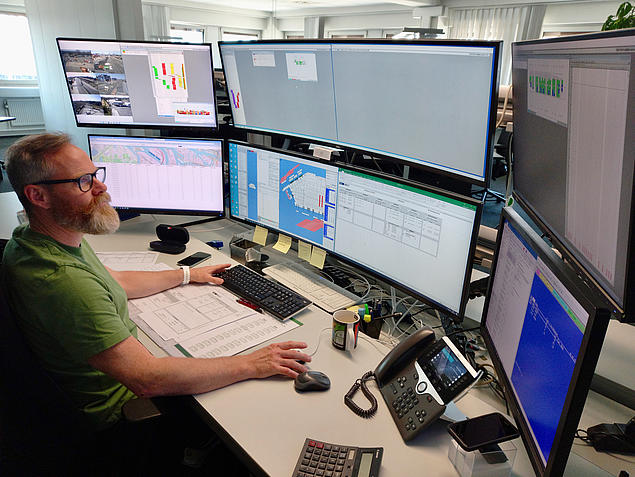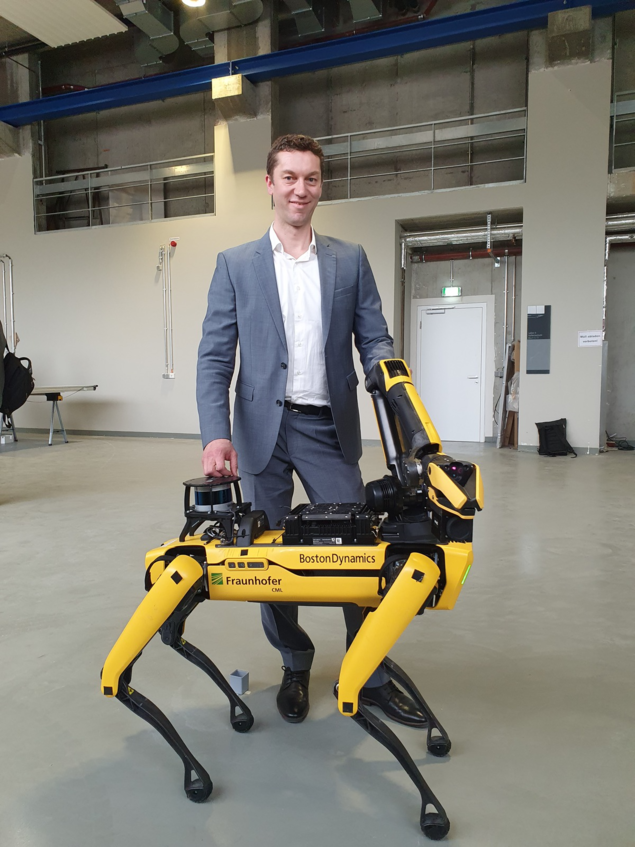
The automatic block storage system at HHLA Container Terminal Burchardkai (CTB) in Hamburg is a groundbreaking project that has attracted the interest of specialists worldwide. It stands for technological, logistical and environmental viability. Also, artificial intelligence is used to increase its efficiency.
The towering portal crane “LK 24 G” rolls in majestically, like a giant steel gate on rails. Its gripping mechanism, the so-called spreader, lowers itself down on steel cables fully automatically to a reddish-orange 20-foot container. It precisely meets the steel box that has just been retrieved from the container rail terminal and set down by the driver of a straddle carrier. From here, the LK 24 G takes over. It’s easy to remember what this abbreviation stands for: “storage crane from block 24, large” (translated from German).
“G” is actually the largest of three portal cranes that simultaneously serve the newest storage block 24. The computer-controlled crane will place the orange container into one of the continuous rows of stacked boxes. The largely automated warehouse crane system (LKS or block storage) is taking over the majority of the container storage process at HHLA Container Terminal Burchardkai (CTB). It lies exactly between the port of Waltershof, with its enormous moored container ships, and the container rail terminal, one of the largest in Europe. There are also lanes for trucks onshore. Up to 2,100 TEU fit in each of the blocks, of which there are currently 19. One TEU is equivalent to one 20-foot container.
Unique: three portal cranes per storage block
The boxes in block storage must be efficiently allocated to save time and space for onward transport. This is the job of the computer-controlled block storage system. Artificial intelligence helps the system predict the likely most favourable storage position.
“Portal crane ‘G’” is so high that it can drive over the slightly lower “L” crane on the land side and the “W” on the water side," explains Gesa Witte, Deputy Head of Terminal Development at CTB. “This allows it to process the land side – the block storage itself – as well as the water side. The system with three cranes passing over each other is unique in the world. In combination with the other two cranes on each side, this makes access particularly flexible.”

HHLA and its partner ABB were the originators of drive-over cranes in block storage. The logistics group now operates more than 100 storage cranes using ABB’s automation technology, including Container Terminal Altenwerder (CTA). Yet CTB is not only using three cranes per block, their stacking of up to six containers is also a record.
Efficiency of the area used increases by 30 percent
Blocks 21 to 24 were commissioned in the course of 2023. In principle, it was a matter of plug and play: they were tested, approved and put into operation . The expansion of the blocks is by now routine. Since the first block (which was assigned number 6) went into operation at Burchardkai 2011, the process has been perfectly rehearsed by everyone involved.
The four new blocks alone represent increased capacity of approximately 8,500 TEU, so that the CTB now has enough space for 39,000 TEU. With the expansion of the LKS, the terminal’s efficiency of space increased by more than 30 percent. This is particularly important in the Port of Hamburg, where space is scarce and every square metre is especially costly.
On the way to climate neutrality
The purchase of the four new blocks brings environmental as well as logistical advantages. HHLA wants to increase not just spatial efficiency but energy efficiency in the Port of Hamburg, and to thereby drastically reduce the use of fossil fuels and the emission of CO2. The Group has set itself the goal of being completely climate-neutral by 2040.
Sustainability at HHLA
It is our aspiration to combine ecological, social and economic interests in order to make our company future-proof. We underline this with our "Balanced Logistics" sustainability strategy.
Read moreThe expansion of block storage is creating important prerequisites for this. Since they can be operated on green electricity, fewer and fewer of the diesel-powered straddle carriers that are still currently widely used will be needed at Burchardkai. Through this measure alone, more than 11,000 tonnes of CO2 are expected to be saved. The CTB is thus on track to receive a certificate for climate neutrality. With this in mind, CTB’s project for storage blocks 21 to 24 is being subsidised by Hamburg’s Ministry for Environment, Climate, Energy and Agriculture (BUKEA)with ten million euros from special European Union funds.

Fewer straddle carriers needed
HHLA is planning additional automation on CTB’s seaborne side. Currently, diesel-powered straddle carriers still transport the boxes back and forth between the quayside and block storage. At 6 of the 10 berths at CTB, they will in future be replaced by battery-driven container transporters (so-called AGVs) that manoeuvre autonomously.
The block storage itself is already highly automated. Remote control operators only take over the handling of containers between storage cranes and trucks onshore. They “drive” the storage cranes with the help of video images from an adjacent room of the terminal control centre on the top floor of a high-rise building.
In the future, the majority of truck containers will also be handled automatically by the system. The main advantage of automated crane operation compared with manual steering lies in its “largely constant and predictable results”, says Johann Bergmann from the Fraunhofer Center for Maritime Logistics and Services CML in Hamburg. The port technology expert adds: “Since work breaks during changes in crane operators or shifts are a non-issue, the crane’s productive operating time is significantly increased.”

Humans still irreplaceable
Nevertheless, experts like shift leader Ralf Meggers, who ensures trouble-free operations throughout the terminal, are irreplaceable – especially in the control centre. His many data monitors normally don’t provide him with a view of the block storage itself. Specialists like Martin Schlüter – a technology operator in charge of monitoring the storage crane system – keep an eye on it for him. It’s a good thing this monitoring system works. Recently, someone accidentally crossed a photoelectric sensor and triggered an emergency safety stop down in the block storage area. Schlüter stops the piercing alarm and, after receiving the all-clear from a colleague on site, releases the track.
Returning from the office, he gets back to the brand-new storage blocks, which currently still end at number 24. The next construction site is already being set up next to this one. A great deal of soil has already been moved, and the area has been developed and prepared. “We expect blocks 25 to 27 to be built here by 2025. 28 and 29 are projected but not yet scheduled,” explains terminal developer Witte. Scheduling them now would be risky since HHLA and its partner ABB must always adapt their expansion planning to the projected volume development of container handling – if only for economic reasons.
Transferring the concept is conceivable
Whatever the future holds, the terminal can hardly be in a better position: it has one highly automated block storage unit, three drive-over cranes per block, up to six boxes can be stacked on top of one another, and everything is in its optimal storage space thanks to AI. Johann Bergmann, the Fraunhofer expert for port technologies, thinks HHLA’s established innovation leadership at Burchardkai could also be of interest to terminal operators elsewhere in the world: “The transfer of this concept to other container terminals that require high block storage productivity is conceivable.”



